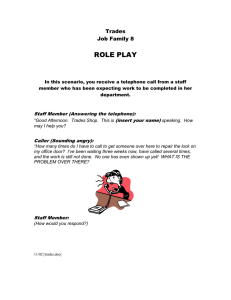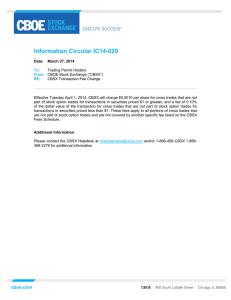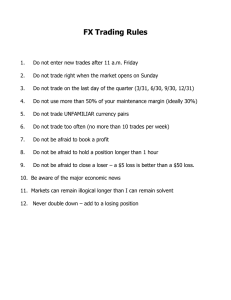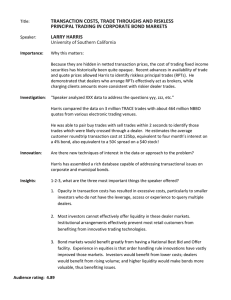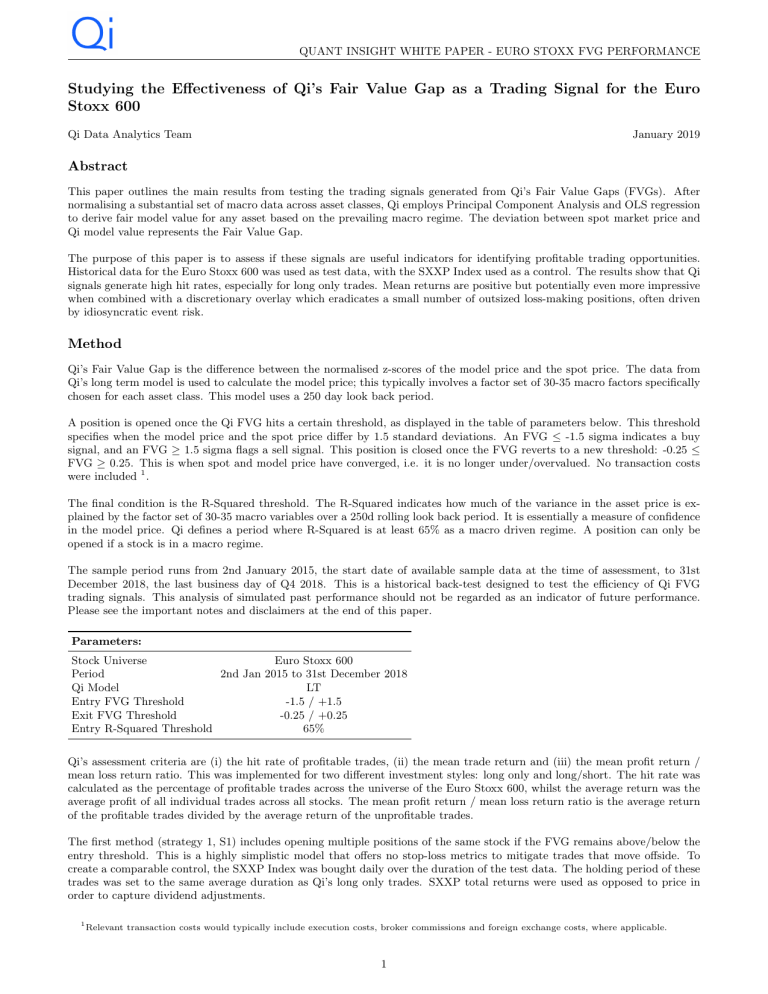
QUANT INSIGHT WHITE PAPER - EURO STOXX FVG PERFORMANCE
Studying the Effectiveness of Qi’s Fair Value Gap as a Trading Signal for the Euro
Stoxx 600
Qi Data Analytics Team
January 2019
Abstract
This paper outlines the main results from testing the trading signals generated from Qi’s Fair Value Gaps (FVGs). After
normalising a substantial set of macro data across asset classes, Qi employs Principal Component Analysis and OLS regression
to derive fair model value for any asset based on the prevailing macro regime. The deviation between spot market price and
Qi model value represents the Fair Value Gap.
The purpose of this paper is to assess if these signals are useful indicators for identifying profitable trading opportunities.
Historical data for the Euro Stoxx 600 was used as test data, with the SXXP Index used as a control. The results show that Qi
signals generate high hit rates, especially for long only trades. Mean returns are positive but potentially even more impressive
when combined with a discretionary overlay which eradicates a small number of outsized loss-making positions, often driven
by idiosyncratic event risk.
Method
Qi’s Fair Value Gap is the difference between the normalised z-scores of the model price and the spot price. The data from
Qi’s long term model is used to calculate the model price; this typically involves a factor set of 30-35 macro factors specifically
chosen for each asset class. This model uses a 250 day look back period.
A position is opened once the Qi FVG hits a certain threshold, as displayed in the table of parameters below. This threshold
specifies when the model price and the spot price differ by 1.5 standard deviations. An FVG ≤ -1.5 sigma indicates a buy
signal, and an FVG ≥ 1.5 sigma flags a sell signal. This position is closed once the FVG reverts to a new threshold: -0.25 ≤
FVG ≥ 0.25. This is when spot and model price have converged, i.e. it is no longer under/overvalued. No transaction costs
were included 1 .
The final condition is the R-Squared threshold. The R-Squared indicates how much of the variance in the asset price is explained by the factor set of 30-35 macro variables over a 250d rolling look back period. It is essentially a measure of confidence
in the model price. Qi defines a period where R-Squared is at least 65% as a macro driven regime. A position can only be
opened if a stock is in a macro regime.
The sample period runs from 2nd January 2015, the start date of available sample data at the time of assessment, to 31st
December 2018, the last business day of Q4 2018. This is a historical back-test designed to test the efficiency of Qi FVG
trading signals. This analysis of simulated past performance should not be regarded as an indicator of future performance.
Please see the important notes and disclaimers at the end of this paper.
Parameters:
Stock Universe
Euro Stoxx 600
Period
2nd Jan 2015 to 31st December 2018
Qi Model
LT
Entry FVG Threshold
-1.5 / +1.5
Exit FVG Threshold
-0.25 / +0.25
Entry R-Squared Threshold
65%
Qi’s assessment criteria are (i) the hit rate of profitable trades, (ii) the mean trade return and (iii) the mean profit return /
mean loss return ratio. This was implemented for two different investment styles: long only and long/short. The hit rate was
calculated as the percentage of profitable trades across the universe of the Euro Stoxx 600, whilst the average return was the
average profit of all individual trades across all stocks. The mean profit return / mean loss return ratio is the average return
of the profitable trades divided by the average return of the unprofitable trades.
The first method (strategy 1, S1) includes opening multiple positions of the same stock if the FVG remains above/below the
entry threshold. This is a highly simplistic model that offers no stop-loss metrics to mitigate trades that move offside. To
create a comparable control, the SXXP Index was bought daily over the duration of the test data. The holding period of these
trades was set to the same average duration as Qi’s long only trades. SXXP total returns were used as opposed to price in
order to capture dividend adjustments.
1
Relevant transaction costs would typically include execution costs, broker commissions and foreign exchange costs, where applicable.
1
QUANT INSIGHT WHITE PAPER - EURO STOXX FVG PERFORMANCE
Qi then refine this process (strategy 2, S2), introducing one example of a potential trading strategy involving momentum
metrics for both Qi’s FVG and model price. In this second strategy only one position may be opened at any one time per
stock. This has the consequence of reducing the universe of trades. However, with the new constraints, it is possible to identify
the signals which are created by shifts in the model price rather than the spot price. Both the conditions below need to be
met to qualify for a trade:
1. Qi’s model price has to be moving in the correct direction to create the signal, i.e. if there was a buy signal (FVG < -1.5),
the one day change in model price must be positive for a position to be opened.
2. The FVG has to stop widening, with the expectation that it has reached its largest gap, and this may therefore create a
stronger signal. An example of this for a buy signal (FVG < -1.5), would be when the FVG passes this threshold but then
sees a 1 day opposite change.
Results
Long only
Table 1: Table of Results
Hit Rate
Average Trade
Duration (days*)
Average #
Trades/day
Average
Return/trade
Average
Profit Return
Average
Loss Return
Win/Loss
Ratio
Long only - S1
66.3%
27.5
6.4
1.5%
6.1%
-7.4%
0.8
Long only - S2
62.9%
28.3
0.3
1.2%
6.2%
-7.4%
0.8
SXXP Index
56.0%
28
1
0.3%
3.4%
-3.5%
0.96
* Trading days.
** A control defined as buying and holding SXXP for the same average duration as a Qi-driven long-only trade (≈ 87 days).
For long only trades in strategy 1, the signals produce profitable trades 66.3% of the time. The average return per trade is
1.5%. This includes all unprofitable trades, which make on average a loss of 7.4%, compared to 3.5% for the SXXP Index.
When a Qi signal is incorrect, the losses tend to be large. This creates scope for even higher profits if the large unprofitable
trades can be identified early.
Equities normally have mild negative skew; however Qi’s returns are more skewed than when trading the SXXP Index. Note
though this is based on a highly simplistic buy/sell & hold scenario with no risk management. A critical observation is that
a small number of large losing trades skew the data; see Appendix.
For long only trades including Qi’s momentum constraints (strategy 2, S2), Qi’s signals produced average returns of 1.2%, an
improvement of 0.9% on the index. This new rule has the effect of reducing the number of trades dramatically, which would
in turn reduce transaction costs.
Figures 1 and 2 are histograms for the percentage return of every long trade in strategy 1 and strategy 2, and Figures 3
and 4 compare these results to the trades in the SXXP control. The red dotted lines in Figures 1 and 2 represent Gaussian
distributions which have been fitted to the percentage return data. The black dotted lines are the means of each data set.
Figures 3 and 4 show the probability density functions for the returns of Qi’s trades and the trades in the SXXP control.
Figure 3 shows that Qi’s trades can generate much higher returns than the SXXP Index, but equally, the unprofitable trades
can be much worse. The main comparison is that there is a greater likelihood of a highly profitable trade when using Qi’s
signals. Once the new momentum constraints are applied in Figures 2 and 4, the negative tails of the return distributions still
exist, meaning some other trading rule or a discretionary overlay is required to minimise these losses.
2
QUANT INSIGHT WHITE PAPER - EURO STOXX FVG PERFORMANCE
Figure 1: Distribution of the percentage returns of
each long only trade in strategy 1.
Figure 2: Distribution of the percentage returns of
each long only trade in strategy 2.
Figure 3: Probability density functions for long only
trades in strategy 1 compared to trades in the SXXP
control.
Figure 4: Probability density functions for long only
trades in strategy 2 compared to trades in the SXXP
control.
Results
Long/Short
Now the same methodology and parameters outlined on page 1 are replicated, using both Qi’s simple (strategy 1, S1) and
constrained (strategy 2, S2) strategy types. This time with the focus on long and short trades.
Table 2: Table of Results
Long/Short - S1
Long/Short - S2
Hit Rate
Average Trade
Duration (days)
Average #
Trades/day
Average
Return/trade
Average
Profit Return
Average
Loss Return
Win/Loss
Ratio
61.3%
59.2%
25.6
26.5
10.4
0.5
0.7%
0.6%
5.6%
6.2%
-6.9%
-6.8%
0.8
0.8
The trades generated by Qi’s FVGs in strategy 1 had a hit rate of 61.3%, with an average return per trade of 0.7%. 10,867
signals were generated over the test period, which resulted in an average of 10.4 positions being opened a day. Each position
was held for an average duration of 25.6 trading days. The average return of solely profitable trades was 5.6%, whereas that
of the unprofitable trades was -6.9%, giving a win/loss ratio of 0.8. Once again a small number of large loss-making trades
have skewed the results; see Appendix.
3
QUANT INSIGHT WHITE PAPER - EURO STOXX FVG PERFORMANCE
Note that this long/short strategy is akin to a market-neutral, absolute return strategy in contrast to SXXP-long only. Indeed,
it is notable that this strategy has delivered higher returns than the SXXP index over the 4 year sample period.
When including the momentum constraints (strategy 2, S2), the hit rate moves to 59.2%. 61% of trades were longs and 39%
were shorts. This is notable given a simple buy and hold SXXP strategy delivers a hit rate of 56.0% during this period.
Critically, Qi outperforms the average returns of the Index by 0.3% per trade.
The histograms below in Figures 5 and 6 show the distributions for the percentage returns of each trade for the two strategies.
Trade returns in strategy 1 have a negative skew, which provides an opportunity to improve hit rates and profits if the negative
tails can be reduced. Strategy 2 eliminates some of the trades in the negative tail, but with a lower hit rate, the average profit
falls marginally.
Figure 5: Distribution of the percentage returns for
each trade in strategy 1.
Figure 6: Distribution of the percentage returns for
each trade in strategy 2.
Conclusion
The results show that the Qi FVGs are able to identify profitable trades, most notably when opening multiple long only
positions. Indeed, this strategy posts a notable 5x outperformance versus SXXP long only. Furthermore, when adhering to
both the buy and sell signals and incorporating momentum constraints (i.e. long/short - S2), Qi again generates returns in
excess of an SXXP-long only strategy.
Qi gives a macro insight into markets and, in a highly simplistic risk management approach, provides high hit rates solely from
the signals driven from the FVGs. Turning that into higher returns depends on finding an overlay that limits the group of
large unprofitable trades. Many of these trades may have been avoidable if other information was available. Therefore Qi can
greatly enhance conviction in a trade if combined with additional resources, see Appendix. Moreover, adding additional constraints into the screening process, such as model momentum, shows how Qi can be used to deliver alpha in a more robust way.
Lastly, this is the fifth in a series of White Papers designed to showcase empirical examples of the Qi output. Here Qi developed
a highly simplistic trading rule into just a more refined trading strategy. Topics to follow include. . .
• Further iterations of trading strategies with different constraints and on different asset classes.
• RSq and macro regimes. How long do regimes last? Which asset class enjoys regimes with the greatest longevity?
• Closing the FVG – model to market or market to model? An empirical look at the most efficient way to capture the
‘correct’ mean reversion.
4
QUANT INSIGHT WHITE PAPER - EURO STOXX FVG PERFORMANCE
Appendix
A small number of large loss-making positions skew the Qi returns data; 7% of trades in strategy 1 resulted in losses of more
than 10%; similarly 6% of trades in strategy 2 also result in losses of more than 10%. A discretionary overlay can help avoid
such out-sized losses. That overview can be a function of both macro and micro factors. Critically though it can have a
substantial impact on P&L. The table below shows the results of implementing a hypothetical discretionary overlay that is
able to mitigate half of the trades which lose more than 10%. In all the instances where a position moved 10% off-side, the
assumption is the investment manager stops out of the trade half the time.
Table 3: Discretionary Overlay - Table of Results
Long only - S1
Long only - S2
Long/Short - S1
Long/Short - S2
Average
Return/trade
SPX Index
Qi Excess
Return
1.9%
1.6%
1.1%
1.0%
0.3%
0.3%
0.3%
0.3%
1.6%
1.3%
0.8%
0.7%
Case studies:
The case studies below provide some real life examples of when a discretionary manager, cognisant of the prevailing environment, would overrule systematic trading signal.
Siemens-Gamesa Renewable Energy
Having completed their merger in the April, the combined entity of Germany’s Siemens and Spain’s Gamesa released their first
combined earnings details for q2’17 at the end of July. Earnings fell around 20% due to a fall in demand for their wind turbines,
predominantly from India who announced a switch to auctioning wind power. By end September, when Qi’s long signal from
end April was finally unwound, the stock price was down 43.6%. A disciplined stop-loss would clearly have mitigated such a hit.
Glencore
Weaker Chinese demand resulted in commodity markets struggling over h1’15 and that pressure forced the Glencore share
price down to a point where a Qi buy signal was triggered on July 28th. A discretionary overlay would have questioned the
buy signal even if only because of caution over the growing bear market in commodities. However, analysts were already
starting to question Glencore’s high level of debt and, by the end of Aug when Qi finally stopped out (with the share price
down 35.1%), pressure was already building for a new corporate strategy to cut debt via asset sales and new share issues.
Perrigo Co PLC
The modest decline in Sopra Steria over September 2018 prompted a Qi buy signal on the 18th of the month. In October,
SOP cut guidance aggressively after “a major commercial opportunity” for its Banking Software business failed to materialise.
That left its FY18 operating forecast some 13% below consensus. Qi’s long was exited on November 6th at a loss of -32.3%,
whereas a prudent risk management approach would have reacted to October’s earnings guidance.
There are several more outsized losses. Qi signalled a short on BTG on November 15th 2018 just a week before Boston
Scientific offered a 36% premium to the prevailing price to buy BTG’s profitable portfolio of live-saving drugs and licensing
business. The simple, systematic approach adopted here does not include any form of risk management to mitigate such
corporate actions. A discretionary overlay would go a long way to help avoid these “landmines” and reduce the average loss
of 7.4% over the sample window described above.
5
QUANT INSIGHT WHITE PAPER - EURO STOXX FVG PERFORMANCE
DISCLAIMER AND TERMS OF USE:
By using any service/product/content developed by Quant Insight Limited (“QI” or “We”) and delivered through the QI website or over email or any other
delivery mode on which these Terms and Conditions appear (each, a “Service” or collectively, “Services”), you the recipient of the Service (“You” or the
“Recipient” hereafter), agree to be bound by all of the terms in these Terms and Conditions. You may wish to print and keep a copy of these Terms and
Conditions. We may change the terms in these Terms and Conditions at any time and such changes will be binding on You if You continue to use a Service
after we have notified You (by email, on a Service, or by any other means by which You obtain such notice) that we have changed the terms. Therefore,
You should review these Terms and Conditions each time we notify You that we have changed the terms. QI may discontinue or change any Service, or its
availability to You, at any time. These Terms and Conditions are personal to You, and You may not delegate Your obligations under them to anyone. If any
provision in these Terms and Conditions is invalid or unenforceable under applicable law, the remaining provisions will continue in full force and effect.
These Terms and Conditions, Your obligations, and all actions contemplated by these Terms and Conditions shall be governed by the laws of England and
Wales, as if these Terms and Conditions were a contract wholly entered into and wholly performed within England and Wales. By using a Service, You
represent, warrant and covenant that You (if You are an individual) are at least 18 years of age, can form legally binding contracts, and (if applicable) are the
authorized representative of the entity that is agreeing to these Terms and Conditions. The Services are not designed for use by individuals under 18 years
of age, and use by such individuals is not permitted. You agree to keep Your login details private and not to share Your user id with anybody else.
Hyperlinks: For the direct or indirect links to external websites (“hyperlinks”), which lie outside our control, QI disclaims any responsibility, or liability as
to such content. QI expressly declares that no illegal content was identified on the linked pages at the time of setting the links and QI has no influence on
the design, content or authorship of the linked pages.
Data Protection: All personal user data collected here will only be stored and used for the purpose of providing user products and services. QI ensures that
this data will be handled in a confidential manner, in conformity with QI’s Privacy Policy. Notwithstanding the foregoing, however, QI cannot ensure or
warrant the security of any personal user data.
LIMITATIONS ON USE
The content available through each Service is the property of QI and is protected by intellectual property laws. Such content may include, for example, studies,
analyses, stories, tools, calculators and other items displayed on the Service. Content received through a Service may be displayed, reformatted, and printed
for Your personal, non-commercial use only. You agree not to reproduce, retransmit, distribute, disseminate, sell, publish, broadcast or circulate the content
received through a Service to anyone, including but not limited to others in the same company or organization, without the express prior written consent of
QI. You may not post any content from any Service to newsgroups, mail lists or electronic bulletin boards without the prior written consent of QI. You may
not use any of the data on a Service in connection with the issuance, trading, marketing or promotion of investment products (e.g., derivatives, structured
products, investment funds, investment portfolios, etc., where the price, return and/or performance of the investment product is based on or related to our
data), nor may You use such data as the basis of a financial instrument, without a separate written agreement with QI and any of our applicable Licensors.
Except as may be permitted above, You agree not to copy, modify, reformat, download, store, reproduce, reprocess, transmit or redistribute any data or
information found on any Service or use any such data or information in a commercial enterprise without obtaining our prior written consent.
Research Use Only
The content on each Service is provided for information and research purposes only, as of the date and time provided, and is subject to change without notice.
Service content is not intended to be an offer, or the solicitation of any offer, to buy or sell any investment product including but not limited to securities.
Service content, including any information regarding the pricing of, or factors affecting, any currencies, securities, indices, financial instruments or any other
assets whatsoever, does not constitute any kind of advice, recommendation or solicitation and may not be relied on in relation to any purchase or sale of any
security, product or investment of any kind or any investment decision or strategy. QI makes no representation as to the suitability of the Services for any
particular purpose. The service content does not take into account the individual circumstances, objectives or needs of any person and does not constitute
any kind of representation that any financial instrument is suitable or appropriate for any person.
To the extent that the service content contains any opinion as to the pricing of, or factors affecting, any instrument or investment of any kind, it should be
noted specifically that such opinion will have been formed on the basis of information made available to QI by third parties, the accuracy of which is outside
QI’s control, has not been independently verified, and as to which QI accepts no responsibility or liability. Furthermore, any such opinion may already be
out-of-date when viewed by the recipient. QI accepts no responsibility to update the information at any time, even in relation to material facts known to QI.
In addition, any such opinion will have been formed only on the basis of the consideration of certain factors determined by QI. The opinion may be different
if there are material factors that have not been considered. In particular, the performance of any investment may be affected by micro factors related to that
investment which are completely unknown to QI and will not have been taken into account in relation to any opinion that may be expressed. Any opinion
in the service content will have been formed on the basis of historic macro factors and projections of future performance by reference to historic factors. In
practice, past movements and factors may not constitute a reliable indicator of future performance.
No Reverse Engineering
The systems used by QI to provide a Service are proprietary and confidential, including but not limited to the computer hardware and software the Service
runs on. Any system for a Service provided by QI shall not be analysed, decompiled, or reverse engineered, nor should You cause a third party to analyse,
decompile, or reverse engineer the same for any purpose.
DISCLAIMER OF LIABILITY AND WARRANTIES
QI AND ITS AFFILIATES, AGENTS AND LICENSORS CANNOT AND DO NOT WARRANT THE ACCURACY, COMPLETENESS OR TIMELINESS OF
THE CONTENT AVAILABLE THROUGH ANY SERVICE. NEITHER QI NOR ANY OF ITS AFFILIATES, AGENTS OR LICENSORS SHALL BE LIABLE
TO THE RECIPIENT OR ANYONE ELSE FOR ANY LOSS OR INJURY CAUSED IN WHOLE OR PART BY USE OF A SERVICE. IN NO EVENT WILL
QI, ITS AFFILIATES, AGENTS OR LICENSORS BE LIABLE TO THE RECIPIENT OR ANYONE ELSE FOR ANY DECISION MADE OR ACTION
TAKEN BY THE RECIPIENT IN RELIANCE ON SUCH CONTENT OR ANY SERVICE. QI AND ITS AFFILIATES, AGENTS AND LICENSORS SHALL
NOT BE LIABLE TO THE RECIPIENT OR ANYONE ELSE FOR DAMAGES OF ANY KIND (INCLUDING, WITHOUT LIMITATION, LOST PROFITS
OR DATA, DIRECT, CONSEQUENTIAL, SPECIAL, INCIDENTAL, INDIRECT, OR ANY OTHER DAMAGES) FROM THE RECIPIENT’S USE OF A
SERVICE EVEN IF ADVISED OF THE POSSIBILITY OF SUCH DAMAGES AND REGARDLESS OF THE CAUSE OF ACTION. TO THE EXTENT
SUCH DISCLAIMER OF DAMAGES IS NOT EFFECTIVE UNDER APPLICABLE LAW, THE ENTIRE AGGREGATE LIABILITY TO THE RECIPIENT
OF QI, ITS AFFILIATES, AGENTS OR LICENSORS WILL BE LIMITED TO THE FEES, IF ANY, THE RECIPIENT PAID TO QI FOR ACCESS TO
THE SERVICE THAT GAVE RISE TO SUCH LIABILITY. EACH SERVICE AND ALL SERVICE CONTENT IS PROVIDED “AS IS” AND QI AND ITS
AFFILIATES, AGENTS AND LICENSORS DISCLAIM ALL EXPRESS AND IMPLIED WARRANTIES WITH RESPECT TO THE SERVICE, INCLUDING
BUT NOT LIMITED TO MERCHANTABILITY, FITNESS FOR ANY PARTICULAR PURPOSE AND NON-INFRINGEMENT OF ANY SERVICE CONTENT, AND THAT A SERVICE WILL BE AVAILABLE, FREE FROM ERRORS, VIRUSES OR OTHER HARMFUL COMPONENTS. ANY CONTENT QI
AND ITS AFFILIATES, AGENTS AND LICENSORS PROVIDE IS TO BE USED BY RECIPIENTS IN ACCORDANCE WITH ALL APPLICABLE LAWS,
AND THE RECIPIENTS WILL BE SOLELY RESPONSIBLE FOR ANY CONSEQUENCES DERIVED FROM ANY USE OF CONTENT INCLUDING,
BUT NOT LIMITED TO, USE THAT RESULTS IN TORT OR CRIMINAL LIABILITY.
The Recipient agrees to indemnify, defend and hold harmless QI, its subsidiaries and affiliates and their respective officers, directors, employees and agents
from any claim, cost, expense, judgment or other loss relating to Your use of the Service, and without limitation of the foregoing, any action You take that is
in violation of these Terms and Conditions. The failure of QI to exercise or enforce any right or provision of these terms shall not constitute a waiver of such
right or provision.
Jurisdiction and Applicable Law: Any disputes related to the access and use of the service shall be governed by and interpreted in accordance with the Laws
of England and Wales.
Quant Insight Limited {FRN: 708235} is an appointed representative of Duff & Phelps Securities Ltd. {FRN: 466588} which is authorised and regulated
by the Financial Conduct Authority. Quant Insight Limited is registered as an investment advisor with the Securities and Exchange Commission.
Quant Insight Limited 50 Liverpool Street, London EC2M 7PR Tel: +44 20 3865 1940
www.quant-insight.com
6
